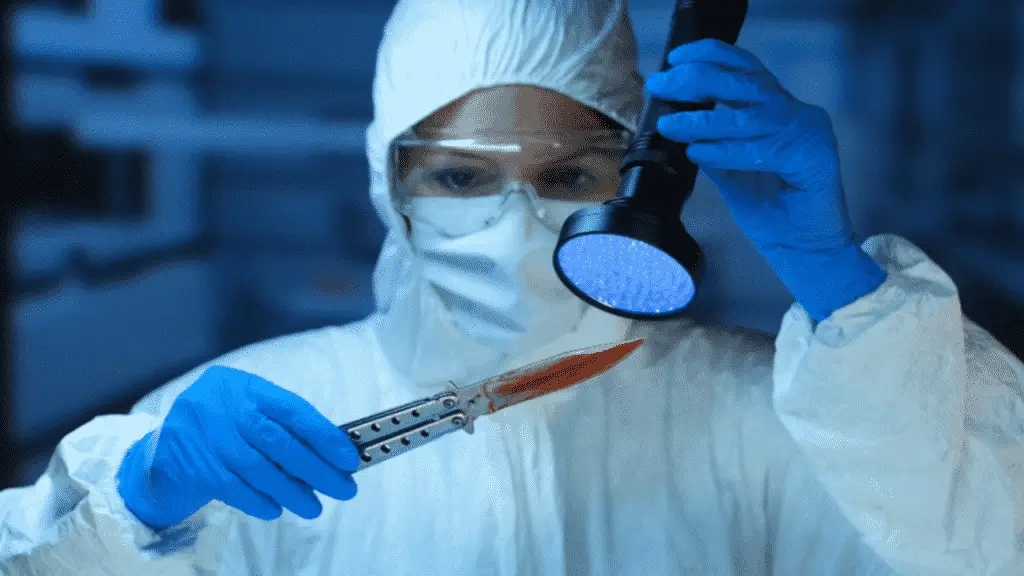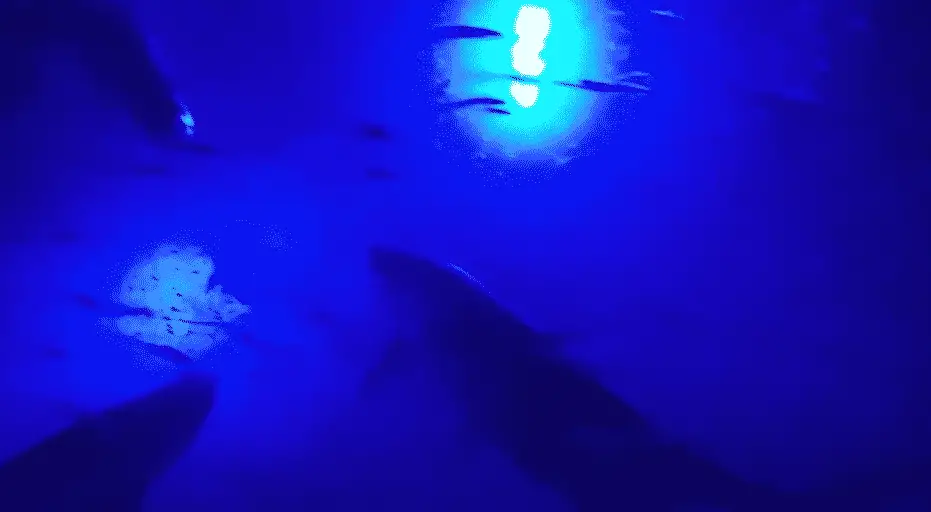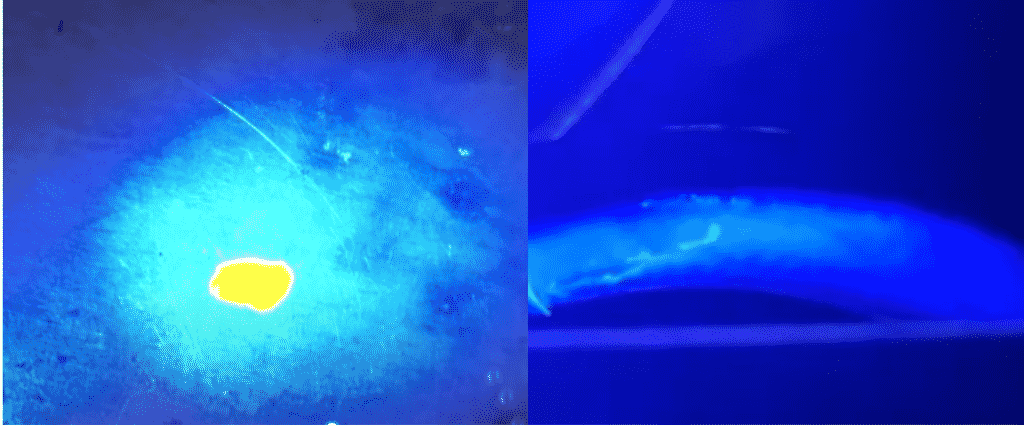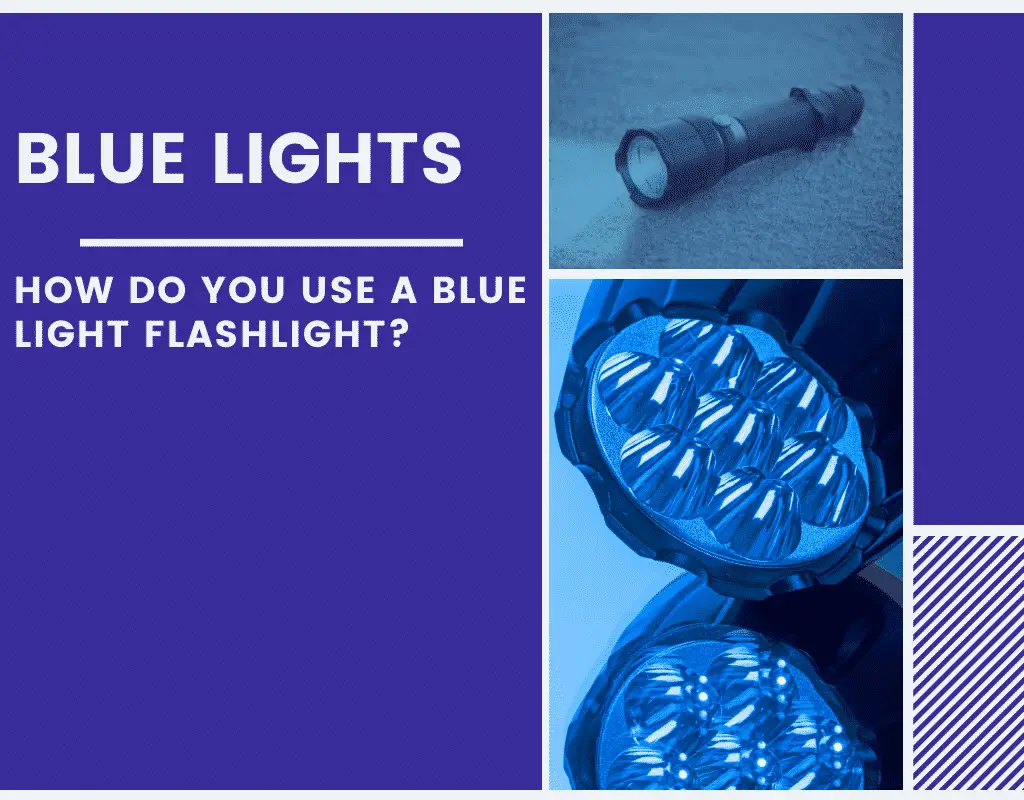I got into a hunting and fishing a few years ago and started looking into different flashlights and headlamps to use at night. After a little bit of research, I noticed that most of the people were using multicolored flashlights red, lights, and blue lights. I knew that red and green lights help with night vision, but I wasn’t familiar with blue light flashlights. I’m so glad that I finally decided to purchase one, but how do you use it?
What is a blue light flashlight used for? Blue light flashlights are used for finding blood splatter, identifying fluid leaks, reading maps/papers in the dark, identifying/drawing in fish and lots of other tasks. They’re commonly used by hunters, fisherman, crime scene investigators, and for lots of other reasons.
Green and red lights will usually be better for preserving night vision, but there are lots of uses for blue lights. They make it easy for hunters to track blood trails, draw in fish for fisherman, help find oil/fluid leaks in cars and industrial equipment, and can be used in many other private/commercial settings.
In the rest of this post, I’ll go over the advantages/disadvantages of blue lights, go over different tasks you can perform, and explain when to use blue, red, green, and white flashlights near the end of this post. You might be surprised that there are other ways to use blue lights outside of hunting applications.
Table Of Contents
Purpose Of Blue Light: What Are Blue Lights Used For?
Blue lights are commonly used by hunters, forensics teams, fisherman, and in industrial applications where you need to find invisible fluids. The fluorescent properties found in most fluids and oils will glow under a blue light.
That’s why blue light is commonly used to spot bloods, oils, chemicals, and anything else with fluorescent properties. Liquids that are usually invisible to the eye will take on a fluorescent glow when blue light is shined on it. I’ll go over the different applications where you can use a blue flashlight below, but here are the main benefits of blue light flashlights
- See Invisible Blood/Oil/Fluids: Blue lights are almost always used to see blood, oils/chemicals, and bodily fluids that would be invisible to the human eye. It picks up the florescent properties in invisible stains and makes them glow giving you a clear picture. That’s why blue lights are used to pick up blood trails, do forensic work, spotlight fish, search for oil/chemical spills, and view any other object with a fluorescent fibers (gemstones,
- Preserve Night Vision: Preserving night vision isn’t the primary purpose of a blue light, but it’s better than white light(worse than red/green). Since most white lights have a blue tint, that makes blue light the closest to a bright white. It’s a little bit better than white, but it will take longer to adjust to brightness/darkness than with reds and greens.
- Increased Natural Clarity Of The Surroundings: I kind of mentioned this above, but blue light is the closest alternative to a standard bright white flashlight. It has some night vision properties, but you’ll have a more natural view of your surroundings in the dark. It’s almost like a dulled down bright white light. Throw in the added glow of invisible fluorescent liquids and that makes blue light perfect for following blood trails and looking for invisible fluids.
- Easier To Read In The Dark: Reading small text and dealing with tiny objects will be easier with a blue light than with red and bright white. It won’t be as sharp as with a green light, but it’s much clearer than red without straining your eyes like a bright white flashlight. You only need 30 lumens of light to read so a bright white flashlight is almost always too powerful for your needs.
- Blue Lights Cut Through Fog: There’s a reason why most modern cars use a combination of standard white and blue headlights. Blue lights are the only option when dealing with fog. It’s rare to get caught in fog that’s so dense that you can’t see through it, but you commonly find fog near large open fields during the hunting season.
Now lets get into a few of the most common times when it makes sense to use a flashlights blue light. I touched on most of them above, so you might want to skip down to the bottom where I go over the different advantages and disadvantages of different color lights.
You may also want to check out my post explaining how to use green light flashlights and red light flashlights. I also have a detailed guide explaining lumen values and a handy flashlight and headlamp lumen chart that you might want to check out.
Blue Light Uses: What’s The Purpose Of Blue Light?
Blue lights aren’t the best option for preserving night vision (Red is Best) or providing contrast/clarity (Green is Best) to your surroundings, so when would you use a blue light on a flashlight? Blue lights are almost always used to find blood, body fluids, oils, and chemicals that would normally be invisible to the human eye. Blue lights have a wide range of uses in professional industries and private market!
You can use blue light for industrial applications to search for chemical, oil, and other leaks/spills. Forensic teams use blue lights to search crime scenes for blood, body fluids, chemicals (like bleach), and other liquids that would be difficult to see. Geologists use blue lights to find/study gems with fluorescent properties (argonite, apatite, calcite, fluorite, powellite, scheelite, sodalite, willemite, and zircon).
In the private/civilian market blue lights are usually used by hunters and fisherman. Hunters use blue light to find and follow blood trails. Fisherman use them to spotlight fish at night while drawing in insects.
Blue Light Is Used By Hunters To Track Prey

Hunters are by far the most common blue light users in the private/hobbyist market. Hunters use blue light to track wounded prey. After shooting an animal, hunters scour the forest searching for the telltale glow of blood. They go from one blood splatter to the next until they finally find the fallen prey.
Looking at the picture above shows the clear difference between spotting blood with a blue light and other colors. That’s a dried blood stain on a jacket, but finding blood on the forest floor is exactly the same.
Most hunters use a red light to get into their treestand since it’s less likely to scare animals away. Green light to spotlight animals at a distance(mostly hogs and small predators like coyote, racoons, possums, etc.) or red lights with deer (animals that get spooked easily). Blue or black lights to follow a blood trail.
Blue lights also helps bow hunters find their lost arrows. Most arrows have use fluorescent colors on the fletching to make them easier to find. The fluorescent fletching glows under blue light making lost arrows easier to find in the dark. A quality arrow/broadhead costs about $50-$100 so you don’t want to lose them in the dark.
Forensic Teams Use Blue Light To Spot Blood Stains, Bodily Fluids, and Other Chemicals

When a forensics team is investigating a crime scene they use a combination of blue light and luminol to make invisible stains glow in the dark. They start off with using blue light to identify potential blood, body oils, semen, saliva, etc. Blue light helps with initial detection, but spraying on luminol is what really makes blood shine
I won’t get into the science of it (I’m too stupid), but luminol causes a chemical reaction in blood that excites the electron state. Iron found in your blood reacts with the luminol causing it to glow. It’s very similar to the chemical reaction found in glow sticks and how fireflies emit light.
Forensics teams typically use black instead of blue lights to search for bodily fluids, but it’s the same basic concept. Black lights emit a blue/purple light that’s actually bluer than a standard blue light. So you get a deeper blue which aplifies the effect of a blue light.
Fisherman Use Blue Lights To Find and Lure In Fish At Night

Fishing lights are available in two primary colors, white and green. They mount the lights underneath their boat, dock, or drop them into the water to draw in plankton. Green lights are by far the best option for drawing in plankton, insects, baitfish, and larger gamefish but white light also works.
Plankton and insects are drawn to bright lights, because it increases algae growth (their food source). Once plankton and insects come to the light that draws in smaller baitfish, and larger game fish are soon to follow. So where do blue lights come in?
Blue lights usually used to spotlight fish since their scales and their body oils glow under blue light. Blue lights shine deep into the water, like green, so you get a greater distance of effective fishing area. They also draw in sport fish in salt water applications, but for some reason it won’t attract bait in fresh water.
Blue Lights Help Find Oil, Fluid, and Chemical Leaks/Spills In Equipment

Most people aren’t pulling out a blue flashlight to search for oil/chemical leaks in their garage, but blue lights are commonly used in industrial settings. They shine the blue light over manufacturing equipment searching for oil, chemical, and coolant leaks.
Using a blue light on heavy equipment allows them to spot leaks before they can become a problem. The picture above shows a small drop of motor oil that’s about the size of a matchhead. You would never be able to spot that tiny drop of oil searching with a typical flashlight. Checking your equipment every once in a while will show you leaks before they become a major problem.
I’ve been using my blue light a lot over the last couple of years to find hydraulic leaks in my farm equipment and leaks in my truck. I don’t have issues with my newer equipment, so it’s mainly used to find leaks in hydraulic hoses on my old Case 580e backhoe and older mid 90s Kubota B2150 subcompact loader.
Running the blue light along the lines makes it easy to find small leaks before they put my equipment out of service. The pinhole leak in my hydraulic hose (pictured above) would have been impossible to find without a blue light. Buying a new high-pressure hydraulic hose is about $250 bucks so replacing all of them at once isn’t an option for a broke guy like me.
Blue Lights Cut Through Fog
Fog reflects white, red, and green lights. Blue lights are the only option when dealing with dense fog. That’s why most cars use a combination of bright white lights for general nighttime driving and blue fog lights for foggy conditions.
I’ve rarely run into a situation where fog was so dense that it was almost impossible to see, but it does happen. It’s common on early morning and late evening hunting trips. Setting up your treestand alongside a large open field or deep in a valley is asking for early morning and late evening fog.
You can usually navigate through fog on foot without a flashlight, but tracking deer can be difficult in foggy conditions. The blue light will help you get through the fog and pick up a blood trail when hunting.
Riding a bike, atv, golf cart, dirt bike, etc. in the fog poses a serious challenge. They don’t have fog lights so you can either drive ridiculously slow or risk crashing into something. You can pick up cheap blue fog lights to hard wire into your electrical system ($20-$30) or pick up battery operated fog lights for a bike.
What Color Light Is Best For Seeing In The Dark? What Do The Other Flashlight Colors Do?
Red is by far the best color for preserving night vision, but green light helps improve contrast and clarity in your surroundings. Blue light is better than white for seeing in the dark, but that’s not its main purpose.
Blue light is almost always used to follow blood trails, find invisible body fluids, and other invisible oils/chemicals. Blue light picks up the fluorescent properties in liquids (making them glow) that are usually invisible to the human eye.
Multicolored flashlights use 4 different colors to improve vision in the dark: white light, red light, green light, and blue light. Each color of light has its own set of advantages and disadvantages. Here’s a brief explanation of when you should use each color light.
- White Light: Everybody’s familiar with flashlights/headlamps that use white light bulbs. White is a great all around light for general use. You can see long distances, read close up, and do just about anything if you want with a high lumen flashlight. The only problem is that it takes forever for your eyes to adjust with white light. Turning on a bright white light is a shock to the system and you’ll immediately lose your night vision.
- Blue Light: Blue light flashlights are mainly used by hunters and crime scene investigators to find blood and other bodily fluids, and by fisherman to spotlight and draw in fish. Blue lights make objects with fluorescent properties (blood, body secretions, oils, etc.) visible that would normally be invisible to the naked eye. It’s also better than white light for preserving night vision, but far worse than red/green light.
- Red Light: Red light is by far the best color when it comes to preserving night vision (greens 2nd best). It slows down the breakdown of the protein in your eye that’s used to adjust to light. Your eyes only use the cones in your eyes (used in daylight) instead of using the rods which help preserve light in dim light. So you maintain your night vision longer and adjust to the light faster. It’s also nearly invisible to animals and less likely to disturb humans than the other colors. The only downside is that it washes out the surroundings so it’s not easy to make out fine details when you’re trying to read small text or navigate tricky terrain.
- Green Light: Green light comes in at a close second behind red when it comes to preserving night vision. Where it really shines is increasing contrast and providing sharp outlines both closeup and faraway. That makes green lights perfect for reading maps/instruments, spotting dark objects at a distance, and getting a clear picture of your surrounding (greens used in most night vision goggles). Animals/humans have a hard time seeing green light (red is better for everything except hogs and small predators), but the high contrast helps pick out dark fur/skin at a distance.




